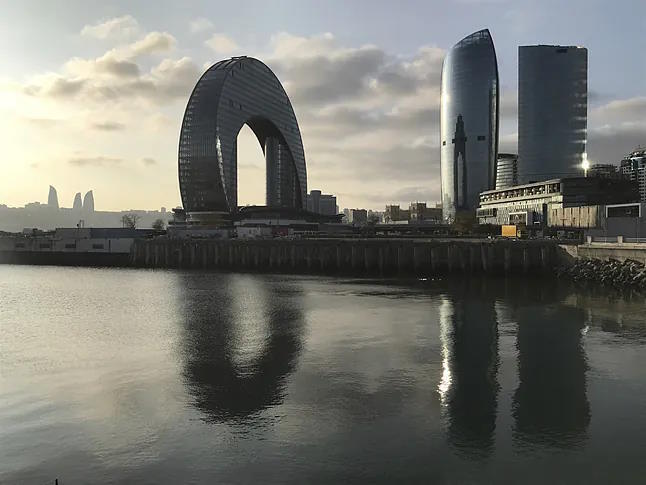"Everything is black: the walls, the ground, the air... You can feel the oil and inhale the emissions: the stench suffocates you. You can walk among real clouds of smoke that cover the skies."
This was the account of a Turkish traveler passing through Baku, the world's first oil city, where up to 90% of the world's oil was produced by the end of the 19th century. The black gold fever reached the southeast of the city, on the shores of the Caspian Sea, in an area known as Black City where the first mechanically pumped oil wells and over a hundred refineries were concentrated.
It was called the Black City because soot covered everything. The hardworking laborers lived in barracks and in inhumane conditions, breathing toxic air day and night. The smell of money attracted great fortunes like Rothschild and entrepreneurs like the Nobel brothers, who built the first oil pipeline of the Russian Empire here.
The Nobels had a Byzantine-style mansion built in Baku, which they named Villa Petrolea. Abandoned for decades, it reopened as the only museum outside of Sweden dedicated to the illustrious family, who fought a peculiar battle with the Black City as a backdrop. Alfred and Ludvig founded the Branobel company for oil extraction in 1879; Robert felt betrayed by his brothers and never set foot in Baku again.
Oil fields in Baku in the early 20th centuryWorld History Archive / Alamy Stock Photo
A century and a half later, under the auspices of President Ilham Aliyev, the swamp of the Black City has given way to the gleaming White City, designed among others by the studios of Atkins and Norman Foster. The idea is to definitively cleanse the city's image and bring it into the 21st century, with the flaming Flame Towers marking the skyline.
But nothing is as it seems in Baku, which strives to project the air of a modern city but carries the weight of the past in its wide and devastating Stalinist avenues, in the Soviet-era blocks, and in the retro atmosphere of its streets devoid of humans and crowded with cars. The wind is uncomfortable at almost all hours, and the heaviness of the "black" past lingers in the air, no matter how much they try to bury it under the White City.
The motto seems to be to "clarify" the present under facades that seem like cardboard. A succession of beige-colored mansard houses turns the place into a poor imitation of Paris, the city that the First Lady, Mehriban Aliyeva, aspires to emulate, who is also apparently behind the idea of building mini-pyramids of the Louvre marking the metro entrances.
Everything in Baku bears the imprint of the ubiquitous president, who also lends his name to the futuristic cultural center Heydar Aliyev, on Heydar Aliyev Avenue, intended to promote the "heritage of the national leader." Designed by Zaha Hadid's studio, it looks more like a delirious monument to whiteness, as if that were the directive in a strange place that still cannot bury the ghosts of the past.
As Aliyev himself said at the start of COP29, "Gas and oil are a gift from God." And indeed, 90% of Azerbaijan's exports are still hydrocarbons. The plan for the next decade is to increase gas production by a third, citing the growing demand from the European Union. This confirms the country's transformation from an Oil State to the new gas giant, leveraging the turmoil of the Ukraine war and maintaining a double game with Russia (Putin visited Baku in August and his presence has also loomed over the Russian pavilion, one of the largest at COP29).
Meanwhile, renewables account for barely 7% of Azerbaijan's energy mix, the land of fire. And although the goal is to reach 30% by 2030, the delay is more than evident: the first large-scale solar plant in Garadagh, an hour from Baku, was inaugurated just a year ago.
The World Bank has warned that Azerbaijan "will not be able to achieve the goals of its Vision 2030 if it continues to persist in its reliance on gas and oil," which could expose it to "market volatility" and leave it out of the global race towards decarbonization.
The ubiquitous presence of Socar, the state oil and gas company, is another sign of the deep contradiction in which the country lives. The President of COP29, Mukhtar Babayev, worked for 26 years precisely for the state oil company before being promoted to Minister of Environment and Resources.
"We are a country of gas and oil, this is our history, and we have no reason to be ashamed," warns Deputy Nigar Arpardarai, chosen for the occasion as a high-level champion of climate in the pompous UN jargon and as a counterpoint to the autocratic petrostate stigma with which the country has been labeled. "We are doing many things and moving towards a new paradigm. Isolating gas and oil-producing countries is not the right path. We need solidarity."
